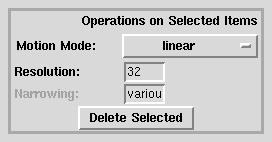Edit Page
Freehand Resolution
This parameters edited here relate only to the creation of Freehand
components.
Operations on Selected Items

This area of the GUI allows operations to be carried out on the components
that have been "selected" in the active MultiView - the items that are
highlighted in red.
Motion Mode
This option controls how objects will move between reference frames. There
are four options:
linear
rotate in front
rotate in plan
rotate in side
If the selected items have different motion modes, then the motion mode
is shown as "various". If the mode is set to a particular value, then all
selected items will take the selected motion mode. The effect of each of
these modes is as follows:
linear
During editing, when a component is rotated by pressing and dragging M3
on a handle, the component rotates about its own center, calculated as
the arithmetic mean of the coordinates of the vertices.
On animation, the effect is somewhat undefined, because an axis of rotation
is selected independently in each of the reference frames, and linear interpolation
of the coordinates of the point defining the axis produce unexpected motion
of the component. For this reason, the following, more predictable motion
modes are provided.
rotate in front/plan/side
During editing, when a component is rotated by pressing and dragging M3
on a handle, the component rotates about the center of rotation. This happens
in all views, irrespective of whether the motion mode is "rotate in front",
"plan" or "side".
On animation, a component will move at a constant angular velocity so
that its center describes an arc about the rotation center for the component.
The center of rotation appears as a small disk in each orthogonal view.
The centers for all selected items may be moved together by dragging with
left mouse. The rotation center for selected items is highlighted in yellow.
Resolution
This parameter is applicable to components of type Ellipsoid, Cylinder
or Cone. These objects are actually drawn as the specified number of flat
surfaces. The larger the number, the smoother and more realistic the image,
but at the cost of longer rendering time. The following examples show the
effect of changing the resolution of a cone from 16 to 64:




The entryfield will be disabled if no items are selected, or if none
of the selected items are of type Ellipsoid, Cylinder or Cone and have
this parameter. If multiple such items are selected, then the entryfield
will contain the common value, if they all have the same resolution, or
"various". Supposing that you wish to give the same resolution value to
all selected items, and the entryfield contains "various". Attempting to
remove "various" with backspace will produce error messages, since this
field expects a numerical value. Therefore, highlight the word and hit
the "Delete" key.
Narrowing
This parameter is applicable only to cones, and specifies the ratio of
the minimum radius to the maximum radius. By default, it is zero, so a
full cone is generated. If set to 1.0, the object becomes equivalent to
a cylinder. The following example illustrates the effect of an intermediate
value:




The behavior of this field with respect to the selection of multiple
items is the same as for the Resolution parameter.
Delete Selected
The selected items are removed from the image. If these items are the only
users of a shader, then that shader will also be deleted.




